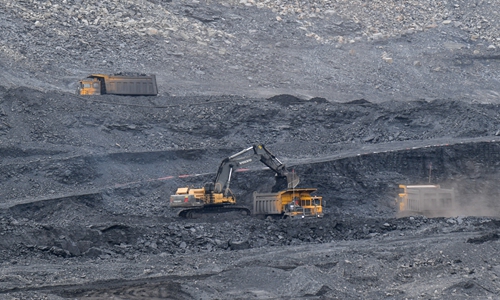SOURCE / INDUSTRIES
China's use of coal in overall energy production continues to decline

A coal mine in Shuozhou, North China's Shanxi Province Photo: cnsphoto
The China Electric Power Planning & Engineering Institute (EPPEI) said Thursday that the proportion of coal in China's energy structure continues to decline while the use of non-fossil fuels continues to rise ahead of targets set in the 13th Five Year Plan (2016-2020).
The situation is expected to improve this year when the use of primary energy is expected to hit 4.85 billion tons of standard coal equivalent, according to the EPPEI.
In 2019, the proportion of coal consumption dropped to 57.7 percent of total energy consumption, while non-fossil energy consumption reached 15.3 percent, allowing China to meet its five-year target in the two sectors, said Xu Xiaodong, vice president of the EPPEI, on an online conference.
The EPPEI released two annual reports during the conference: China Electricity Development Report 2019 and China Energy Development Report 2019.
China's installed capacity of electricity generation was 2.01 billion kilowatts in 2019, a year-on-year increase of 5.8 percent, and its power generation capacity was 7.3 trillion kilowatt-hours, a year-on-year increase of 4.7 percent, said Liu Shiyu, director of planning department of the EPPEI, citing from the China Electricity Development Report 2019.
In the next three years, the growth of new energy consumption will be approximately 210 million kilowatts in China. In northern areas of China, new energy consumption will increase by approximately 87 million kilowatts, Liu said.
Over the same period, large-scale offshore wind power could face difficulties in reaching the grid in some coastal provinces, so related projects need to be further considered, Liu said.
In 2020, global energy consumption will drop as much as eight percent from a year earlier because of the COVID-19 pandemic. It will resume growth in 2021, but below previous forecasts, said Chen Zheng, director of energy research department of the EPPEI, citing from the China Energy Development Report 2019.
China's total primary energy consumption is expected to reach approximately 4.85 billion tons of standard coal equivalent in 2020, a year-on-year decrease of 0.2 percent from 2019, said Chen.
In 2020, the consumption of primary energy including coal and oil will decline in China, but the consumption of electricity will maintain growth, Chen said.
Chen said that total primary energy consumption will increase an average of 2.5 percent per year from 2021 to 2025, which is lower than the average annual growth rate of 3.1 percent from 2016 to 2019. By 2025, primary energy consumption is expected to reach 5.46 billion tons of standard coal equivalent.
China's electricity consumption is expected to hit about 7.4 trillion kilowatt-hours in 2020, a year-on-year increase of 2.8 percent from 2019, said Chen.
From 2021 to 2025, electricity consumption is expected to increase by an average of 4.2 percent annually, which is lower than the average annual growth rate of 5.6 percent from 2016 to 2019. By 2025, electricity consumption will reach about 9.1 trillion kilowatt-hours, Chen said.
During the 14th Five-Year Plan period (2021-2025), international oil prices will remain at low levels. The price of West Texas Intermediate will range from $40 to $47 per barrel, which is lower than the 2019 level, Chen predicted.
